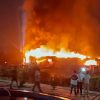Goa is abuzz with excitement as vintage bike and car owners, users, collectors and fans are decking […]

TREAT KIDS LIKE YOUNG ADULTS! BY MICHELLE WOO
Children, Nov 13- Nov 19 2021 November 12, 2021RESPECT: Your child needs to be respected. Just because he is smaller than you does not mean he is less intelligent then you. Treat children as you would any adult person
By Michelle Woo
Nothing irritates a kid as much as ‘kuchikoing’ mothers. If your kid is three years or above talk to him normally as you would to any adult. If your kid says he has gone to the moon do not correct him. If a four-year-old kid lecture you on various kinds of dinosaurs do not think they are stupid!
Greetings, small human, how’s the weather down there?’ is probably not your best opener
You’re at a holiday gathering, scoping out the scene as the dignified adult you are, and you find yourself making eye contact with a young child. They stare at you for a beat, silently, and then ask whether you think Charizard can beat Squirtle.
You stand there, confused. You consider pivoting back to the table of assorted hummus dips, but you know that you should probably engage. The problem is you have no idea how.
I used to get uncomfortable talking to little kids. I was stumped by their out-of-the-blue questions, befuddled by their stories that don’t track, intimidated by their unpredictability. But after having kids of my own (and spending a lot of time exploring this topic), I’ve come to realize that conversations with children can be downright delightful, as long as you don’t lead with the dreaded “So, uh, how’s school?” I canvassed some other people I’ve deemed “good with kids” — fellow parents, friends, colleagues, and therapists. Here are their tips for how to talk to young children.
Don’t change your voice
A lot of people do that high-pitched cartoon-voice thing when talking to kids. It’s weird for everyone, the kids included. While it’s true that babies respond best to singsongy tones, if a child is past the toddler stage, just talk like yourself. You might simplify some of your phrases, but there’s no need to dumb down your words. They’re socks, not “sockies.”
Believe the unbelievable
Children say some wild things. Go with it. If a kid tells you she just jumped to the moon, don’t be that adult who says, “Actually, gravitational forces keep you on Earth, so that’s scientifically impossible.” Ask her what she did there, who she met, and whether she brought back any souvenirs.
Avoid the ‘Huh?’
There may be times when a kid is talking to you, and you have no clue what they’re saying. It’ll only frustrate them if you keep asking, “What? Can you repeat that? A race car? A vase scar?” Instead, do what my friend Ada does and go on a quest for more clues. “I’ll usually start asking ‘What do we do?,’ ‘How do we do that?,’ ‘Where is it?,’ and hope one of these questions leads to more information,” she says.
Ease yourself in
Opening with a big, formal introduction — “Hello! What’s your name? Nice to meet you! May I join your activity?” — will only intimidate some kids. Skip the formalities and just gently involve yourself in whatever they’re playing or doing.
My friend Julieann, who works with children as an occupational therapist, uses this approach often. “If kids are coloring, I might hang out at the table and color with them,” she says. “Then I’ll make little comments like, ‘Hmm, what color do you think I should use here?’ or, ‘Wow, that looks really cool.’ The idea is to transport yourself into their world.”
Be okay with silence
My colleague Liz, a mom of two, points out that in conversations with very young children, there will likely be pauses. Get comfortable with that.
“It may take them up to 30 seconds to process what you’re saying and respond, so it’s good to take a beat,” she says. Liz reminds us that we’re not failing if a kid isn’t responding to every question we ask. Sometimes they just won’t. It doesn’t mean they’re not enjoying our company.
Name-drop kid interests
This is a tactic I like to use. Instead of asking kids a string of questions, which can feel like an interview, casually slip familiar kid interests into your own stories. Here’s an example:
“I was at work, and someone was talking about a Hatchimal. I didn’t know what that was.”
“I know what a Hatchimal is! I have one!”
“Really? Is it a food?”
“No, it’s a toy!”
“Whoa, tell me more.”
Get resourceful
If you’re sitting at a table with a kid and the conversation has stalled, it might be time to get crafty. What’s in your bag? You can fold an old receipt into a boat, swirl a tornado in a half-empty water bottle, or make parachutes out of square napkins by twisting the corners. Or be like my husband and pull out the ol’ bendy pen trick at every opportunity. Kids always seem to dig it.
Learn some games
My six-year-old daughter, Maggie, is a fan of the game “Would You Rather…?” (“Would you rather have a pig’s tail or a horse’s mane?” “Would you rather have 20 puppies or one dragon?”). There are also the classics: “Name That Tune,” “20 Questions,” and “Telephone” (if you’re with multiple kids).
Avoid the cheap tricks
By this, I mean trying to connect with kids by tickling them, play fighting (the children may like it, but their parents probably won’t), or asking them if they have a boyfriend or girlfriend.
And while it might seem like a well-intentioned icebreaker, don’t comment on how “cute” or “pretty” they are or what “a heartbreaker” they’re going to be (ick). There are tons of better ways to engage with kids (see above) than making small talk that teaches them that their appearance matters more than anything.
Follow their lead
Sometimes, a kid just won’t want to talk to you. It’s important to get the hint. My friend Catherine, who’s a family coach, says to pay attention to their body language. “If a child giggles or smiles, chat away,” she says. “If she curls behind a parent or doesn’t make eye contact, take a step back and slow down.”
Be yourself
Remember that it’s a conversation, not a performance. Says my friend Corinne: “I think adults who don’t spend a lot of time with kids sometimes think they have to say something interesting that will endear themselves to the kid. This is not accurate. There is literally nothing you can say to make a kid think you are cool. Just be polite to each other and try not to make it any weirder than it has to be.”
Kids look to adults for cues on how to act. If you’re uncomfortable or distracted, they will be, too. But if you show a genuine curiosity about what they like, what gets them excited, or what makes them laugh, they’ll open up. Children, it turns out, can be wonderful conversationalists if they feel you are genuinely interested in them. They’re just like us. Only with more slime.
Courtesy:www.forge.medium.com















